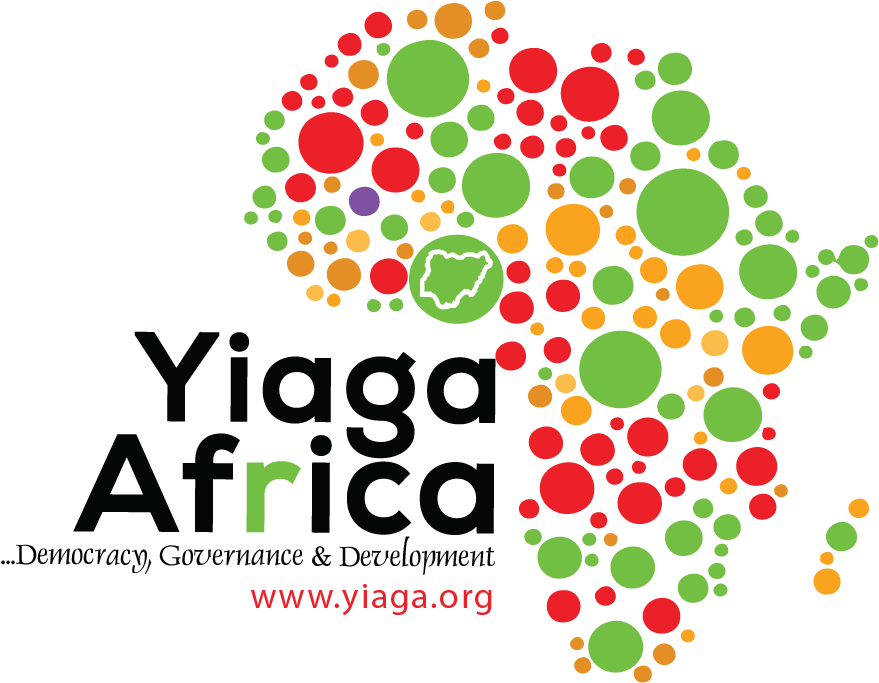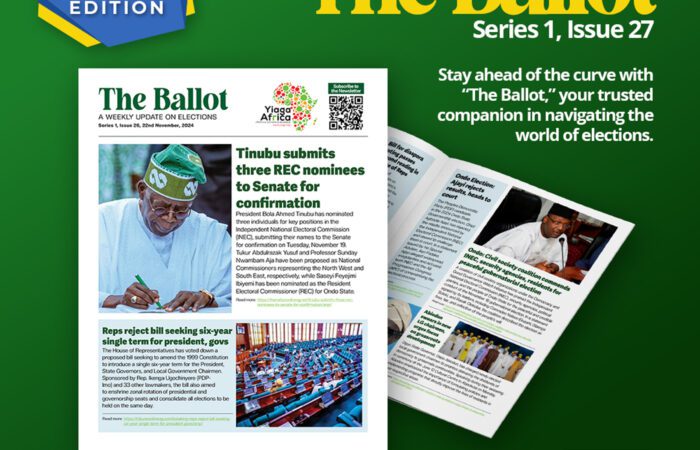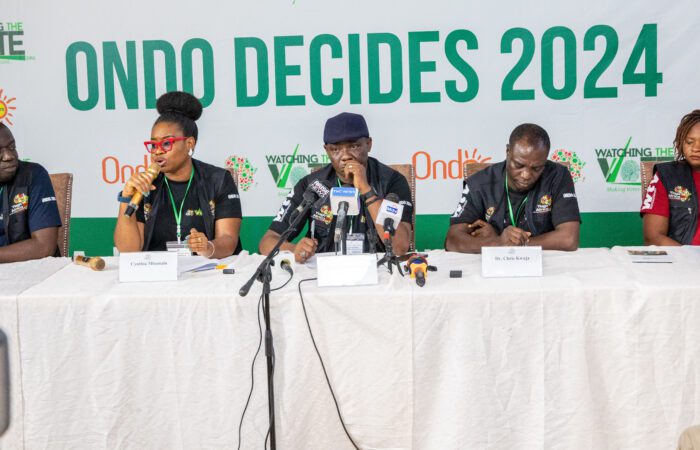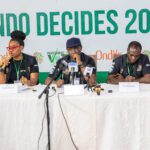YIAGA #WatchingTheVote
PRELIMINARY STATEMENT ON THE 2016 ONDO GOVERNORSHIP ELECTION
Sunday, November 27, 2016
Delivered at the Royal Birds Hotel, Akure
Introduction
Ladies and gentlemen of the press, on behalf of the #WatchingTheVote Working Group of the Youth Initiative for Advocacy, Growth and Advancement (YIAGA), it is our pleasure to welcome you to this post-election press briefing.
YIAGA’s #WatchingTheVote employed the parallel vote tabulation (PVT) methodology as part of its observation of the 2016 Ondo state gubernatorial election. The PVT is an advanced observation methodology that uses well-established statistical principles and sophisticated information technology. PVTs provide the most timely and accurate information on the conduct of voting and counting, and is the only observation methodology that can independently verify the accuracy of official Independent National Electoral Commission (INEC) election results.
YIAGA undertook #WatchingTheVote to provide voters, candidates, political parties, and INEC with independent information about whether the official results for the Ondo gubernatorial election truly reflect the ballots cast at polling units. If INEC’s official results fall within YIAGA’s estimated range, then the public, political parties and candidates should have confidence that the official results reflect the ballots cast at polling units. If the official results do not reflect the ballots cast, #WatchingTheVote will expose it.
About YIAGA
YIAGA is a civil society organization that promotes democratic governance, human rights and youth political participation. YIAGA’s approach includes research, capacity development and public policy advocacy. Since inception, the organization has carved a niche for itself as one of Nigeria’s frontline civil society organizations, promoting participatory democracy, human rights and accountability. Registered with the Corporate Affairs Commission CAC/IT/No.38620, YIAGA represents 21st Century “think and do” tank in Nigeria and Africa.
#WatchingTheVote’s Methodology
During Ondo’s gubernatorial election, #WatchingTheVote deployed 340 stationary and 23 mobile citizen observers to a representative random sample of 300 polling units. There are sampled polling units in all 18 local government areas (LGAs) of Ondo. The sample is carefully constructed by a trained statistician to ensure every LGA is included proportionally in the sample. The number of sampled polling units for each LGA is therefore based on the percentage of polling units and registered voters in that LGA. For example, Ilaje LGA has 9.0% of all polling units in the state (271 of 3,009) and 9.0% of polling units in the #WatchingTheVote sample (27 of 300) are in Ilaje.
#WatchingTheVote citizen observers deployed to sampled polling units at 7:00 am. They observed setup of polling units, accreditation, voting, counting, announcement and posting of results. Throughout the day, #WatchingTheVote citizen observers sent in seven coded text messages providing structured data on the quality of the electoral process as well as the official results for their polling unit as announced by the poll official.
#WatchingTheVote is not an exit poll. No voter is asked for whom he/she voted. #WatchingTheVote uses the official results as announced and posted at polling units. INEC poll officials at polling units are the ones who count the ballot papers. #WatchingTheVote citizen observers do not count the ballot papers themselves. Rather they observe the counting process and report on the conduct of that process and the official result for polling units as announced by the poll officials.
Since the official results collected by #WatchingTheVote observers come from a representative random sample of polling units, by adding those results together, #WatchingTheVote is able to estimate the results for the gubernatorial election. The estimate is produced within a range, known as the margin of error, based on well-established statistical principles. If INEC’s official results are consistent with YIAGA’s #WatchingTheVote estimate, then the official results reflect the ballots cast at polling units.
Summary of Preliminary Findings
Ladies and gentlemen, the accreditation, voting and counting processes have concluded, and it is our pleasure to welcome you to this press conference to share with you our preliminary findings on the conduct of polling on both days. Our statement today is only about the processes of setting up of polling units, accreditation, voting, counting and posting of results at polling units. YIAGA will issue its verification statement on the accuracy of the official Ondo gubernatorial results immediately after INEC’s announcement.
Set-up and Start of Accreditation and Voting
Based on reports from 99% of observers at representative random sample of 300 polling units, YIAGA finds that across the state, the polling process afforded Nigerians a largely credible opportunity to exercise their right to vote. YIAGA noted an improved deployment of INEC poll officials and materials as compared to recent off-cycle gubernatorial elections, which saw 65% of polling units open by 7:30 am, and accreditation and voting begun by 10:00 am at 95% of polling units. Our observation also revealed that card readers were used throughout accreditation in 96% of polling units.
INEC Poll Officials and Procedures
#WatchingTheVote observers reported that INEC poll officials followed electoral procedures. At 100% of polling units, the poll officials made a tick against accredited voters’ names on the voter register. Also, at 100% of polling units, the poll officials marked with indelible ink a finger on the left hand of an accredited voter. At 98% of polling units, every voter received a ballot paper that was stamped, signed and dated by a polling official. Perhaps most significantly, no voter at nearly 100% of sampled polling unit was accredited to vote without a permanent voter card (PVC).
Effects of Collapsing Accreditation and Voting
Additionally, due in large part to INEC’s decision to collapse the accreditation and voting processes, the polls ended swiftly. At 23% of polling units, accreditation and voting ended before 2 pm, and by 3 pm, 89% of polling units had completed. As for the counting process, by 4 pm, 85% of polling units had completed, and by 6 pm, another 14% of polling units had completed.
Two-Step Verification of PVCs
However, issues still remain with the PVC and card reader’s use. While only 4% of polling units had card readers that were not used throughout accreditation, some areas of the state were particularly problematic around completing two-step verification. YIAGA anticipated this, and as part of the #WatchingTheVote PVT, a pilot project was conducted where observers deployed in teams of two to sampled polling units in the two riverine LGAs of Ese-Odo and Ilaje. One observer recorded the method by which every voter was accredited with a tally sheet. This tally sheet recorded whether the PVC was verified, whether the PVC was authenticated, whether the card reader recognizes the voter’s PVC but not his or her fingerprints, whether the individual votes but the card reader was not used, or if the person was not permitted to vote for any reason.
Overall, 58% of voters at sampled polling units in the two riverine LGAs were accredited according to the two-step card reader process. However, the following polling units in Ilaje LGA had extremely high percentages of manual accreditation – meaning the card reader successfully processed the voter’s card, but not his or her fingerprints and the voter was still permitted to vote. This raises doubts about the adherence to the INEC procedures for accrediting voters using the card reader in some polling units.
| Table 1: Rates of manual accreditation of voters in key polling units of Ilaje LGA | |||
| No. | Polling Unit Name | Ward | Rate |
| 1 | Alape Junction: Open Space Alape Junction | Aheri | 79% |
| 2 | Okonla II C & S Primary School Okonla | Etikan | 83% |
| 3 | Odun Oloja, Open Space at Ogunbayos House Odun Oloja | Mahin 1 | 89% |
| 4 | Obe Bowoto, Open Space at Bowoto Beach | Ugbo V1 | 89% |
| 5 | Yonrin 11, C & S Primary School Yonrin | Ugbo V1 | 77% |
Secrecy of the Ballot
Secrecy of the ballot remains a challenge in some areas during Ondo’s elections. It was observer that at 14% of polling units, voters could not vote in secret. Also, 12 critical incident reports described voters to have displayed their ballots before placing in the ballot box. Secrecy of the ballot is a fundamental dimension of democratic elections and INEC should continue to review its material deployment and voting procedures to allow voters to cast their ballots freely and without exposing their voting preference.
Presence of Political Party Agents
While there were calls to delay the election around concerns about the ability of a particular party to deploy their agents, #WatchingTheVote observers reported that All Progressives Congress (APC), People’s Democratic Party (PDP) and Alliance for Democracy (AD) had party agents at 98%, 96% and 95% of polling units, respectively.
Critical Incidents
YIAGA established a Critical Incident desk as part of its State Information Centre to receive urgent messages from its 340 stationary observers. Over the course of Election Day, YIAGA confirmed 61 incidents witnessed by #WatchingTheVote citizen observers, of which 42 were recorded in Ondo South senatorial district. Ilaje LGA was particularly problematic with 14 critical incidents, while Ondo Central senatorial district on the whole had 13.
The most frequent incident reports recorded by #WatchingTheVote citizen observers related to vote buying and bribery (17), card reader malfunction (13), voters publicly displaying their ballots before placing in the ballot box (12), and intimidation or harassment of voters, poll officials or party agents.
To a moderate extent, #WatchingTheVote observers reported not being permitted to observe (7) or community collusion (7). Very few incidents (less than three) were reported related to accreditation of people without PVCs (1), accreditation of voters without the card reader (1), partisan poll officials (1), vehicles without license plates (1), roadblocks (1), gang of party supporters (1), ballot box snatching or stuffing (2), and poll officials not posting results (3). None of these incidents were widespread enough to undermine the credibility of the process overall.
Conclusion
YIAGA would like to thank the many Nigerians across the state who volunteered to be citizen observers. YIAGA also appreciates the collaboration of our development partners and the supportive role the international community has played in promoting credible and peaceful elections. YIAGA once again commends the professionalism of the vast majority of security agents, the commitment and ingenuity of the National Youth Service Corp (NYCS) members who served as poll officials. YIAGA also commends the Resident Electoral Commissioner, Mr. Segun Agbaje, and the Chairman of INEC, Prof. Mahmood Yakubu, for their resilience throughout the conduct of the Ondo gubernatorial election, particularly in the lead up to election day when there was enormous pressure to delay the polls. Finally, and most importantly, YIAGA lauds the voters who went out to exercise their fundamental right to vote.
Long live Ondo state. Long live Nigeria. Thank you.
Samson Itodo
Executive Director
For media inquiries please contact:
Cynthia Mbamalu: Tel. +234 (0) 806 076 3786
Email: coambamalu@gmail.com
David Oluwaseun: Tel. +234 (0) 803 694 3120
Email: pheemy_david@yahoo.com
Learn more about #WatchingTheVote at www.watchingthevote.org or on social media on Facebook at fb.com/yiaga.org or on Twitter @YIAGA.
Annex
Preliminary Findings
Setup of Polling Units
- At 65% of polling units, INEC poll officials had arrived by 7:30 am. Generally, INEC poll officials arrived at more polling units in Ondo North senatorial district than Ondo South senatorial district.
- Approximately 19% of polling units were divided into two or more voting points.
- Two in four of poll officials were women.
- On average, there were five party agents at polling units.
- APC, PDP and AD had party agents at 98%, 96% and 95% of polling units, respectively.
- At 98% of polling units, there were security agents.
- No polling units were without a card reader.
Accreditation and Voting
- At 95% of polling units were open, and accreditation and voting had begun by 10:00 am.
- At 96% of polling units, the card reader was used throughout accreditation of voters.
- At 97% of polling units, the card reader functioned through accreditation or, if it had an issue, it was resolved.
- At nearly 100% of polling units, voters’ fingers were checked for indelible ink.
- At 97% of polling units, the poll officials checked Permanent Voter Cards (PVC) using the card reader.
- At 93% of polling units, the poll officials checked voters’ fingerprints using the card reader.
- At 95% of polling units, the poll officials checked every voter’s PVC against the voter register.
- At 100% of polling units, the poll officials made a tick against accredited voters’ names on the voter register.
- At 100% of polling units, the poll officials marked with indelible ink a finger on the left hand of an accredited voter.
- At 98% of polling units, every voter received a ballot paper that was stamped, signed and dated by a polling official.
- At 93% of polling units, no one was accredited to vote who had indelible ink on the cuticle of one of his or her fingers. However, at 6% of polling units, all voters who already had indelible ink on the cuticle of a finger were permitted to vote.
- At 93% of polling units, no one was accredited to vote without the card reader authenticating the voter’s PVC.
- No one voted without having their PVC checked against the voter register.
Voting Process
- Voters could mark their ballots in secret at 86% of polling units.
- At 6% of polling units, there were incidents of intimidation, harassment or violence during accreditation and voting. In Ondo South senatorial district, this was particularly high at 10%.
- At 11% of polling units, poll officials were crowded by voters during accreditation and voting.
- At 23% of polling units, accreditation and voting ended before 2 pm. By 3 pm, accreditation and voting ended at 89% of polling units.
- At 17% of polling units, people in the queue when accreditation and voting finished were not given an opportunity to vote.
Counting Process
- On average, five polling agents were present at every polling unit for counting.
- At 96% of polling units, poll officials counted unused ballot papers.
- At 89% of polling units, poll officials counted spoilt ballot papers.
- At 90% of polling units, poll officials counted the ballot paper counterfoils.
- At 98% of polling units, poll officials showed how every ballot paper was marked to all present.
- At 12% of polling units, an AD party agent requested a recount. Also at 12% of polling units, an APC party agent requested a recount. Further, at 12% of polling units, a PDP party agent requested a recount. Each of the parties tended to request at a higher rate in Ondo South senatorial district (close to or above 20%) while in Ondo Central senatorial district, the parties requested at a rate of 2% or lower.
- At 4% of polling units, there were incidents of intimidation, harassment or violence during counting.
- At 85% of polling units, counting was completed by 4 pm. An additional 14% of polling units completed counting by 6 pm.
Posting
- Nearly 100% of observers agreed with the results at their assigned polling unit.
- At 93% of polling units, results were posted for the public.






